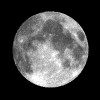
| Bad Astronomy |
|
|
|
BA Blog
|
|
Q & BA
|
|
Bulletin Board
|
| Media |
|
|
|
Bitesize Astronomy
|
|
Bad Astro Store
|
|
Mad Science
|
|
Fun Stuff
|
| Site Info |
|
|
|
Links
|
| RELATED SITES |
| - Universe Today |
| - APOD |
| - The Nine Planets |
| - Mystery Investigators |
| - Slacker Astronomy |
| - Skepticality |
Buy My Stuff

Keep Bad Astronomy close to your heart, and help make me
filthy rich. Hey, it's either this or one of those really
irritating PayPal donation buttons here.
Phases of the Moon
It's safe to say that almost everyone on the planet has seen the Moon hundreds or thousands of times in their lives. It is bright, big, and when it's up it dominates the night, washing out light from the fainter stars. Yet it is the object of so many instances of Bad Astronomy! People think it does not rotate, that the Moon only generates one tide per day, and it looks bigger on the horizon because we are comparing it to foreground objects.These may be subtle instances, not obvious to a casual observer, but some misconceptions arise because people don't really think about what they are seeing or why. Probably the most obvious feature of the Moon is that it undergoes phases; different parts of it are lit at different times. These phases are obvious to anyone who has seen the Moon more than once in their lives. Sometimes the Moon is Full, a big round white circle in the sky, and sometimes it is the thinnest of slivered crescents, hard to find in the glow of sunset.

The most common incorrect reason given for the cause of the Moon's phases is that we are seeing the shadow of the Earth on the Moon! But this cannot be correct: when the Moon passes through the shadow of the Earth, we get a lunar eclipse. Anyone who has seen a lunar eclipse, though, might remember that the Moon actually passes through the Earth's shadow only rarely, so that can't be why the Moon has phases. The real reason for the Moon's phases depends on two things: the Moon is round, and the angle it makes with the Earth and Sun changes over its orbit.
There are probably hundreds of web sites that describe just how this works, but Nick Strobel's Astronomy notes is one of the best I've seen. He has an excellent diagram and description of how the phases work. I link to his website a lot; he has a very good writing style and describes quite a bit of basic astronomy thoroughly and understandably. I reference it a lot myself as well!
Another good site that has a lot of info about the Moon is at the U.S. Naval Observatory, where you can get the rise and set times of the Moon, Sun and planets as well.
Incidentally, the nifty animation of the moon phases at the top of this page is courtesy of Ed Stephan who has done lots of interesting animations.
|
|
|
|